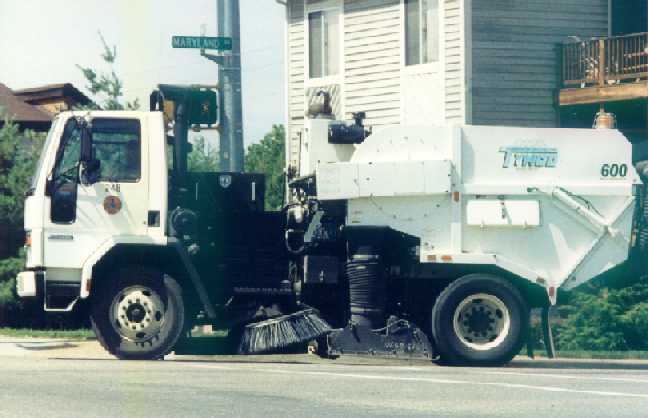Street Sweeping

Description
Street sweeping is a non-structural method of controlling pollutants in storm water. It is essentially a source reduction practice. It involves the use of mechanical or vacuum pavement cleaning equipment (and sometimes, manual labor), to remove particulates from the pavement surface prior to wash-off by storm water runoff. To be effective in controlling storm water pollution, sweeping must be conducted regularly. Vacuum sweepers are more effective than brush or broom sweepers because they do a better job at picking up fine-grained particulates (clays, silts, fine sands) in addition to coarse materials (sand and gravel) and debris.
|
Applicable DEP Stormwater Management Policy Performance Standards
|
Standard #4. Street Sweeping is the only nonpoint pollutant source control measure for which DEP provides a credit for TSS removal.
|
|
TSS Removal
|
DEP Credit:
|
Up to 10%. Street sweeping program needs to be specified in an Operations and Maintenance Plan that ensures sweeping on a regular basis.
|
|
Estimated Range from Literature:
|
<5% to >50%; varies widely with frequency of sweeping and type of cleaning equipment
|
|
Relative Cost
|
Capital Cost: High (street cleaning equipment)
Maintenance: Low to high; varies widely with frequency of sweeping and type of equipment
|
|
Potential Constraints to Use
|
- Equipment availability
- Limitations on use imposed by high traffic volumes on certain roadways
- On street parking in highly developed urban areas
|
|
Other Considerations
|
- Vacuum sweepers are generally more effective than mechanical (brush or broom) sweepers
- Dry weather sweeping is generally more effective than wet weather sweeping
- Pollutant removal rates are directly related to frequency of sweeping; generally street sweeping program must be aggressive to obtain effective pollutant reduction. Refer to Primary Reference and other literature for additional information on removal effectiveness as a function of frequency and type of equipment.
|
|
Disposal of Street Sweepings
|
Dispose of street sweepings in accordance with Reuse and Disposal of Street Sweepings, MA DEP Bureau of Waste Prevention, Final Policy #BWP-94-092. http://www.mass.gov/dep/bwp/dswm/files/stsweep.htm
|
|
Primary Reference
|
Young, et. al., 1996
|
References
Smith, Kirk P., 2002, Effectiveness of Three Best Management Practices for High-Runoff Quality along the Southeast Expressway, Boston, Massachusetts, USGS, Water-Resources Investigations Report 02-4059.
http://water.usgs.gov/pubs/wri/wri024059/
Tiefenthaler, L. L.; Schiff, K. C.; Bay, S. M., 2001, Characteristics of Parking Lot Runoff Produced by Simulated Rainfall, Appendix F of the City of Long Beach Storm Water Monitoring Report 2000-2001, prepared by the Southern California Coastal Water Research Project, July 2001.
ftp://ftp.sccwrp.org/pub/download/PDFs/characteristics_of_parkinglot_runoff.pdf
U.S. EPA, 1983, Results of the Nationwide Urban Runoff Program, Volume 1, Final Report, Office of Water, Washington, D.C.
Waschbusch, Robert 2003, Data and Methods of a 1999-2000 Street Sweeping Study on an Urban Freeway in Milwaukee County, Wisconsin, USGS, Open File Report 03-93.
http://wi.water.usgs.gov/pubs/ofr-03-93/ofr-03-93.pdf
Zarriello, Phillip J., Breault, Robert F., and Weiskel, Peter K., 2002, Potential Effects of Structural Controls and Street Sweeping on Stormwater Loads to the Lower Charles River, Massachusetts, USGS, Water Resources Investigation Report 02-4220.
http://water.usgs.gov/pubs/wri/wri024220/